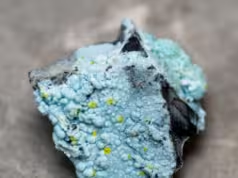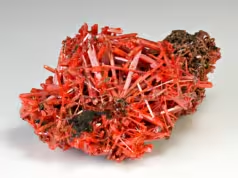Cinnabar is a naturally occurring mercury sulfide mineral with the chemical formula HgS. It is one of the most common and well-known sources of mercury. Cinnabar typically exhibits a striking red to reddish-brown color, which is often associated with its historical use as a pigment for creating red pigments, including vermilion.


Color: Cinnabar is renowned for its deep red color, making it visually distinctive. This vibrant hue has made it a sought-after material for various artistic and decorative purposes.
Occurrence: Cinnabar is typically found in hydrothermal vein deposits, often associated with other ore minerals. It forms under high-temperature and pressure conditions.
Mercury Source: Mercury, a toxic heavy metal, is obtained from cinnabar through a process called roasting. When cinnabar is heated, it decomposes, releasing mercury vapor. This vapor can be condensed and collected for various industrial purposes.
Historical Uses: Cinnabar has a long history of use as a red pigment in art, particularly in ancient China and Mesoamerica. It was used to create the bright red color known as vermilion. However, because of the toxicity of mercury, its use in this context has largely been replaced by safer pigments.
Symbolism: Cinnabar has cultural and symbolic significance in various traditions. In Chinese culture, it has been associated with immortality and used in ancient burial rituals. In alchemy, mercury was often represented by cinnabar.
Health Concerns: Cinnabar is highly toxic due to its mercury content. Inhaling or ingesting mercury vapor or dust from cinnabar can lead to severe health issues, including neurological damage. As a result, its use as a pigment has largely been abandoned in favor of safer alternatives.
Mineralogy: Cinnabar crystallizes in the trigonal system, typically forming prismatic or tabular crystals. It has a relatively low hardness on the Mohs scale, making it relatively easy to scratch.
Due to its striking color and historical significance, cinnabar continues to be of interest to mineral collectors, even though its use as a pigment and a source of mercury has declined due to health and environmental concerns.
Name: From the Medieval Latin cinnabaris, traceable to the Persian zinjifrah, apparently meaning dragon’s blood, for the red color.
Association: Mercury, realgar, pyrite, marcasite, stibnite, “opal”, “chalcedony”, barite, dolomite, calcite.
Polymorphism & Series: Trimorphous with metacinnabar and hypercinnabar.
Crystallography: Rhombohedral; trigonal-trapezohedral. Crystals usually rhombohedral, often in penetration twins. Trapezohedral faces rare. Usually fine granular massive; also earthy, as incrustations and disseminations through the rock.
Diagnostic Features: Recognized by its red color and scarlet streak, high specific gravity, and cleavage.

Contents
Chemical Properties of Cinnabar
| Chemical Classification | Sulfide mineral |
| Chemical Composition | HgS |
Physical Properties of Cinnabar
| Color | Cochineal-red, towards brownish red and lead-gray |
| Streak | Scarlet |
| Luster | Adamantine to dull |
| Cleavage | Perfect Perfect {1010} |
| Diaphaneity | Transparent in thin pieces |
| Mohs Hardness | 2.0–2.5 |
| Specific Gravity | 8.176 |
| Diagnostic Properties | Association with volcanic activity. |
| Crystal System | Trigonal |
| Tenacity | Sectile |
| Fracture | Irregular/Uneven, Sub-Conchoidal |
| Density | 8.176 g/cm3 (Measured) 8.20 g/cm3 (Calculated) |
Optical Properties of Cinnabar


| Type | Anisotropic |
| Anisotropism | High |
| Optic Sign | Uniaxial (+) |
| Birefringence | δ = 0.351 |
| Relief | Very High |
Cinnabar Occurrence and Formation

Cinnabar occurs and forms primarily in hydrothermal vein deposits, where it develops under specific geological conditions. Here’s a more detailed explanation of the occurrence and formation of cinnabar:
Geological Setting: Cinnabar is commonly found in regions with volcanic activity and hydrothermal systems. These geological settings provide the necessary conditions for the formation of cinnabar deposits.
Hydrothermal Veins: Cinnabar typically forms in hydrothermal veins, which are fissures or fractures in rocks that have been filled with mineral-rich hot fluids. These hot fluids are often composed of water containing dissolved minerals and are heated deep within the Earth’s crust.
Source of Mercury: Mercury is a key component in the formation of cinnabar. Mercury can be sourced from various geological processes, including volcanic activity and the alteration of pre-existing rocks containing mercury-bearing minerals.
Precipitation: The process of cinnabar formation begins when hot hydrothermal fluids carrying dissolved mercury come into contact with host rocks that contain sulfur-rich minerals. The sulfur can be derived from various sources, including the surrounding rocks or from the volcanic environment.
Temperature and Pressure: The formation of cinnabar is favored by high-temperature and high-pressure conditions. These conditions cause the mercury and sulfur to react, forming mercury sulfide (HgS) crystals, which make up cinnabar.
Crystallization: As the hydrothermal fluids cool and lose pressure, the cinnabar crystals precipitate and grow within the fissures and fractures of the host rocks. The distinctive red color of cinnabar is a result of the specific arrangement of its mercury and sulfur atoms.
Associations: Cinnabar is often found alongside other minerals, such as quartz, calcite, and various sulfide minerals. These associated minerals are often indicative of the specific geological conditions and can vary depending on the locality.
Secondary Deposits: In some cases, cinnabar can also be found in secondary deposits, such as in alluvial (river) deposits or as a result of weathering and erosion of primary cinnabar-bearing rocks. These secondary deposits are usually the result of the transportation and concentration of cinnabar by natural processes.
Cinnabar deposits are distributed worldwide, with notable occurrences in regions with active or ancient volcanic activity, as well as areas associated with hydrothermal systems. While cinnabar is visually striking and historically significant, its extraction and use have been curtailed due to the toxic nature of mercury, which is released during the processing of cinnabar. Additionally, environmental concerns related to mercury pollution have led to stricter regulations regarding its mining and processing.
Cinnabar Mining Sources and Distribution

Cinnabar mining sources and distribution have been historically significant due to cinnabar’s use as a source of mercury and its vivid red pigment. Here is information on cinnabar mining sources and its distribution:
Sources of Cinnabar Mining:
- Primary Cinnabar Deposits: The primary source of cinnabar mining is from hydrothermal vein deposits, as explained earlier. These deposits are found in specific geological settings associated with volcanic activity and hydrothermal systems.
- Mercury Mining: Cinnabar is primarily mined for its mercury content. Mercury has been used in various industrial applications, including in the production of thermometers, fluorescent lights, batteries, and as a catalyst in chemical processes.
- Artistic and Pigment Use: Cinnabar was historically mined for its use as a red pigment, particularly in art. However, its use in pigments has declined significantly due to its toxicity, and safer alternatives have replaced it in art and decorative applications.
Distribution of Cinnabar:
- Historical Sources: Cinnabar mining has a long history, with notable historical sources including:
- China: Ancient China was a major source of cinnabar for its use in traditional Chinese art and cultural practices. Chinese cinnabar deposits are well-known and have been worked for centuries.
- Mesoamerica: Pre-Columbian cultures in Mesoamerica, such as the Aztecs and Maya, also mined cinnabar for its use as a pigment. Cinnabar was used in the creation of vivid red murals and artifacts.
- Spain: Spain was another historic source of cinnabar, and it played a role in the global cinnabar trade during the colonial period.
- Modern Mining: While cinnabar mining for artistic and pigment use has diminished, modern mercury mining still occurs in various parts of the world. Some notable regions with cinnabar deposits and mercury mining operations include:
- China: China continues to be a significant producer of mercury from cinnabar deposits. It has modern mining operations and is one of the largest mercury producers globally.
- Kyrgyzstan: Kyrgyzstan is known for its cinnabar deposits and mercury mining activities.
- Algeria: Algeria has cinnabar deposits, and it has been involved in mercury mining.
- Spain: Spain still has cinnabar deposits, although the mining of cinnabar for mercury has significantly decreased due to environmental and health concerns.
- Secondary Deposits: In addition to primary cinnabar deposits, secondary deposits may contain cinnabar. These secondary deposits can result from erosion and weathering processes that concentrate cinnabar in riverbeds and alluvial deposits.
It’s important to note that the mining of cinnabar for mercury production has faced increased scrutiny and regulation due to environmental and health concerns associated with mercury pollution. Many countries have implemented strict regulations to mitigate the environmental impact of mercury mining and processing. As a result, the production and use of mercury, derived from cinnabar, have declined over the years, with efforts to find safer alternatives and reduce mercury emissions.
Application and Uses Areas

Cinnabar and its derived products, particularly mercury, have historically found various applications and uses across different areas. However, it’s important to note that many of these uses have declined or been replaced due to health and environmental concerns associated with mercury. Here are some of the application and use areas of cinnabar and its products:
- Mercury Production:
- Cinnabar is primarily mined for its mercury content. When cinnabar is heated, it decomposes, releasing mercury vapor. This vapor can be collected and condensed into liquid mercury, which has been used in numerous applications.
- Thermometers:
- Liquid mercury has been a common component in glass thermometers. However, the use of mercury in thermometers has been reduced due to environmental concerns and the availability of alternative temperature measurement methods.
- Fluorescent Lights:
- Mercury vapor is used in fluorescent lighting. When an electric current is passed through mercury vapor, it emits ultraviolet light, which then interacts with phosphor coatings to produce visible light. Efforts have been made to reduce mercury content in newer energy-efficient bulbs.
- Batteries:
- Mercury oxide batteries have been used in various applications, such as hearing aids, cameras, and electronic devices. However, these batteries are being phased out in favor of more environmentally friendly alternatives.
- Electrical Switches and Relays:
- Mercury-wetted switches and relays were once common in electrical applications due to their reliable performance. These have largely been replaced with solid-state devices due to environmental concerns.
- Chemical Processes:
- Mercury has been used as a catalyst in various chemical processes, particularly in the production of chlorine and caustic soda. Alternatives have been developed to reduce the use of mercury in these processes.
- Gold and Silver Mining:
- Mercury has been used in small-scale gold and silver mining operations to extract precious metals from ore. This practice, known as amalgamation, poses serious environmental and health risks and is being discouraged or banned in many regions.
- Art and Pigments:
- Historically, cinnabar was used as a red pigment in art, creating a vivid red color known as vermilion. However, this use has declined significantly due to the toxicity of mercury, and safer pigments are now favored in art and restoration.
- Traditional Medicine:
- In some traditional medicines, cinnabar was used, but its use has been largely discontinued due to concerns about mercury poisoning.
- Cultural and Spiritual Practices:
- Cinnabar has been used in various cultural and spiritual practices, particularly in Chinese traditions, where it was associated with immortality and used in burial rituals.
It’s important to emphasize that the use of mercury and cinnabar in many of these applications has come under scrutiny and regulation due to the toxicity of mercury and its environmental impact. Efforts have been made to reduce mercury usage and emissions, promote safe handling, and develop alternatives in various industries.
References
- Bonewitz, R. (2012). Rocks and minerals. 2nd ed. London: DK Publishing.
- Handbookofmineralogy.org. (2019). Handbook of Mineralogy. [online] Available at: http://www.handbookofmineralogy.org [Accessed 4 Mar. 2019].
- Mindat.org. (2019). Cinnabar: Mineral information, data and localities.. [online] Available at: https://www.mindat.org/min-727.html [Accessed 4 Mar. 2019].

































